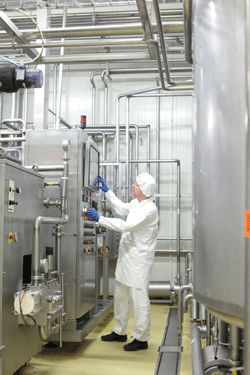By Steve Best
Last year the Riddet Institute published a report titled “A Call to Arms” in response to the government’s 2010 Economic Growth Agenda, which established an increased target of 30-40 percent of GDP by 2025.
For the food and beverage sector that is a threefold increase from the current $20 billion to $60 billion with a compound annual growth rate (CAGR) of approximately seven percent.
Since then a mixed response to the report’s recommendations has seen some initiatives realised and others falling behind.
One of the authors of the report, Dr Kevin Marshall says while he is heartened by a number of government and industry led initiatives, the failure to take on board the long called for central body (the report calls for the formation of an Agri-food board) to lead our export growth in the food and beverage sector is disappointing.
“A Call to Arms” is a comprehensive analysis of the food and beverage industry’s performance – its weaknesses and strengths – that makes a number of vital recommendations to lift our export levels to the seven percent CAGR needed to realise the government’s targets.
The report sets out four transformational strategies:
- Selectively and profitably increase the quantities and sales of the current range of agri-food products
- Profitably produce and market new, innovative, high value food and beverage products
- Develop value chains that enhance the integrity, value and delivery of New Zealand products and increase profits to producers, processors and exporters
- Become world leaders in sustainability and product integrity
While these strategies have been raised before in other reports or papers or strategic objectives, the point of difference in this report is the realisation that implementation, not discursive ramblings are sorely needed to deliver increased export targets in the food and beverage sector.
“They are all [the four transformational strategies]critically important and complement one another but they have not yet been adequately acted on to achieve the level of growth targeted for the sector,” say the authors of the report.
While it is often easy to blame central government inaction or failure, the report instead points the finger at industry itself and at industry leadership in particular.
“Government has taken many effective steps in the last few years that will contribute to accelerating growth of the agri-food sector. The agri-food industry must now make the most of the opportunities provided by these initiatives. The targets have been set. Government has set direction and committed increased effort and resources. Industry must now act.”
Futhermore, at the time of release Dr Marshall said, “Our strategies are neither new nor unique, but, in the past, implementation by industry has failed. Crucially we have provided a pathway and a proposed mechanism for action that will work. There is urgency now, because New Zealand faces a mediocre economic future if we don’t drive the major recommendations in this report to fruition.
“Agri-food leaders need to know what to do, how to do it and how to develop the resources they need to do it effectively.”
Nearly a year later, how close are we to achieving the critical seven percent CAGR? Dr Marshall points out there has been no growth in food exports this year and in the years 2009-2013 there has only been a growth rate of 2.3 percent. There is still much to be done if we are to heed the call to arms as a call to action.
However, Dr Marshall does not view all that has happened since the report’s release as negative and instead points out many encouraging signs that may be steps in the right direction. A boot camp of food industry leaders held at Stanford in the US last year was definitely encouraging, Dr Marshall says.
“Industry leaders from New Zealand were addressed by international food industry leaders and they were saying the same things.”
Dr Marshall also says that the Coriolis report, “An Investor’s Guide to the New Zealand Food & Beverage Industry 2013” was on the same tack as the Riddet Institute report, as was the Ministry of Primary Industries’ report to new ministers at the start of this year that looked to double returns from the primary sector by 2025.
“They are saying the same thing as us,” Dr Marshall says.
The Primary Growth Partnership, looking at funding for optimising land and sea use, as well as an increasing number of companies such as Fonterra and Landcorp taking technology offshore was further signs of heading in the right direction, Dr Marshall says.
But in the end it is the authors of the report’s call to leaders in the New Zealand food and beverage sector to form a cohesive board and transform ideas into reality that will be the critical factor in optimising and increasing the value of our food and beverage exports.




























































































